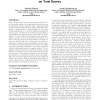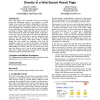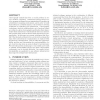WWW
2011
ACM
13 years 6 months ago
2011
ACM
The clustering coefficient of a node in a social network is a fundamental measure that quantifies how tightly-knit the community is around the node. Its computation can be reduce...
WWW
2011
ACM
13 years 6 months ago
2011
ACM
Many real-life graphs such as social networks and peer-topeer networks capture the relationships among the nodes by using trust scores to label the edges. Important usage of such ...
WWW
2011
ACM
13 years 6 months ago
2011
ACM
Online peer-to-peer (P2P) lending services are a new type of social platform that enables individuals borrow and lend money directly from one to another. In this paper, we study t...
WWW
2011
ACM
13 years 6 months ago
2011
ACM
Web search engines have historically focused on connecting people with information resources. For example, if a person wanted to know when their flight to Hyderabad was leaving, a...
WWW
2011
ACM
13 years 6 months ago
2011
ACM
Many malicious activities on the Web today make use of compromised Web servers, because these servers often have high pageranks and provide free resources. Attackers are therefore...
WWW
2011
ACM
13 years 6 months ago
2011
ACM
WWW
2011
ACM
13 years 6 months ago
2011
ACM
The problem of answering SPARQL queries over virtual SPARQL views is commonly encountered in a number of settings, including while enforcing security policies to access RDF data, ...
WWW
2011
ACM
13 years 6 months ago
2011
ACM
The multimedia information retrieval community has dedicated extensive research effort to the problem of content-based image retrieval (CBIR). However, these systems find their ma...
WWW
2011
ACM
13 years 6 months ago
2011
ACM
Choreography analysis has been a crucial problem in service oriented computing. Interactions among services involve message exchanges across organizational boundaries in a distrib...
WWW
2011
ACM
13 years 6 months ago
2011
ACM
Recently answers for fact lookup queries have appeared on major search engines. For example, for the query {Barack Obama date of birth} Google directly shows “4 August 1961” a...




